
Olearia axillaris, commonly known as coastal daisy-bush, coast daisy-bush or coastal daisybush is a species of flowering plant in the family Asteraceae and is endemic to coastal areas of Australia. It is an erect, bushy shrub with densely cottony-hairy branchlets, aromatic, linear to narrowly elliptic or narrowly lance-shaped to egg-shaped leaves with the narrower end towards the base and small white and yellow, daisy-like inflorescences.
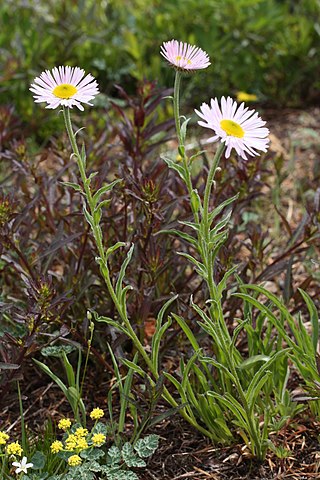
Erigeron peregrinus is a North American species of flowering plants in the family Asteraceae known by the common name wandering fleabane.

Comesperma ericinum, commonly known as heath milkwort, pink matchheads or pyramid flower, is a slender shrub of the family Polygalaceae. It grows to between 1 and 1.5 metres high and branches out vertically. The leaves are 5 to 25 mm long and 1 to 4 mm wide. Purple, lilac-pink or white "winged" flowers are produced in clusters at the end of the stems from October to January.
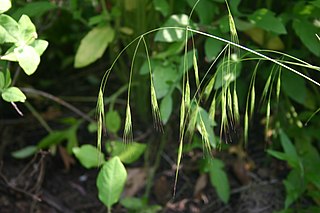
Schizachne is a genus of Eurasian and North American plants in the grass family. The only accepted species is Schizachne purpurascens, commonly called false melic. Three subspecies are recognized:
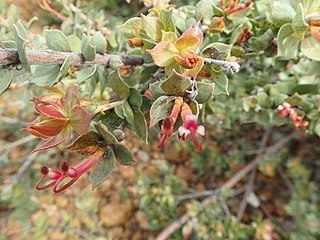
Adenanthos venosus is a species of flowering plant in the family Proteaceae and is endemic to a restricted part of the southwest of Western Australia. It is an openly-branched shrub with clustered egg-shaped leaves and reddish flowers.
Nephroia diversifolia is a vine with the common name sarsaparilla or correjuela. It is native to Arizona, Texas, and much of Mexico as far south as Oaxaca. It is a vine climbing up to 3 m, with white to yellowish flowers and dark purple fruits up to 6 mm in diameter.
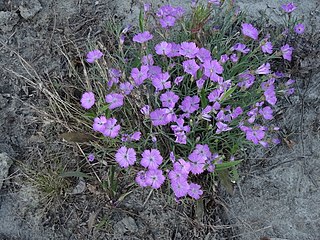
Dianthus repens, common names boreal carnation and northern pink, is a plant species native to the Nei Mongol region of China, as well as to Siberia, the Russian Far East, northern parts of European Russia, Alaska and Yukon Territory.
Cherleria yukonensis, the Yukon sandwort or Yukon stitchwort, is a plant species native to Yukon and Northwest Territories of Canada, as well as Alaska, and The Russian Far East. Flora of North America and some other publications also report it from British Columbia, but more recent work shows those collections to have been misidentified. Cherleria yukonensis grows in dry, rocky meadows at elevations less than 1000 m.

Claytonia ogilviensis, common name Ogilvie Mountains spring beauty, is a plant endemic to the Ogilvie Mountains and the Dawson Range in the Yukon Territory of Canada. These mountains extend into Alaska, and one of the known populations is less than 1 km from the border, so it would not be surprising if the plant were to be found in Alaska as well.
Persoonia hakeiformis is a species of flowering plant in the family Proteaceae and is endemic to the south-west of Western Australia. It is an erect or spreading to low-lying shrub with mostly smooth bark, linear leaves and bright yellow flowers borne in groups of up to sixty along a rachis up to 100 mm (3.9 in) long.

Hovea chorizemifolia, commonly known as the holly-leaved hovea, is a species of flowering plant in the family Fabaceae and is endemic to the south-west of Western Australia. It is a small, upright shrub with prickly, green leaves and blue-purple pea flowers.
Sofya Georgiyevna Tamamshyan (1901–1981) was a Russian-Soviet botanist and plant taxonomist noted for describing 7 genera and more than 50 species, and for authoring over 120 works. The standard author abbreviation Tamamsch. is used to indicate this person as the author when citing a botanical name.

Scaevola glandulifera, the viscid hand-flower, is a shrub in the family Goodeniaceae, endemic to Western Australia.
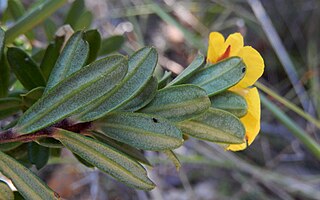
Hibbertia bracteata is a species of flowering plant, in the family Dilleniaceae, and is endemic to eastern New South Wales. It is a shrub with lance-shaped to oblong leaves and yellow flowers with about sixteen stamens arranged on one side of the two carpels.

Tremandra stelligera is a flowering plant in the family Elaeocarpaceae. It is a small upright shrub with pink, purple or blue flowers, dark green oval shaped leaves and is endemic to Western Australia.
Olearia chrysophylla is a species of flowering plant in the family Asteraceae and is endemic to eastern Australia. It is a shrub with scattered elliptic leaves, and white and yellow, daisy-like inflorescences.
Olearia elaeophila is a species of flowering plant in the family Asteraceae and is endemic to the south-west of Western Australia. It is a small shrub with scattered linear leaves, and white or blue and yellow, daisy-like inflorescences.

Leucopogon capitellatus is a species of flowering plant in the heath family Ericaceae and is endemic to the south-west of Western Australia. It is an erect, more or less glabrous shrub that typically grows to a height of 0.2–1 m. It has linear to lance-shaped leaves longer than about 12 mm (0.47 in) long, tapering to a rigid point on the tip. The flowers are borne on short spikes on the ends of branches or in leaf axils on short side branches, with small bracts and bracteoles about half as long as the sepals. The sepals are broad, about 2 mm (0.079 in) long and the petals white and about 4 mm (0.16 in) long, the petal lobes longer than the petal tube.

Styphelia racemulosa is a species of flowering plant in the heath family Ericaceae and is endemic to the south-west of Western Australia. It is an erect, rigid shrub with linear leaves and white, tube-shaped flowers usually arranged in pairs or threes in leaf axils.

Billardiera variifolia is a species of flowering plant in the family Pittosporaceae and is endemic to the southwest of Western Australia. It is a twining shrub or climber with elliptic adult leaves and groups of deep purple flowers that fade to blue as they age.














